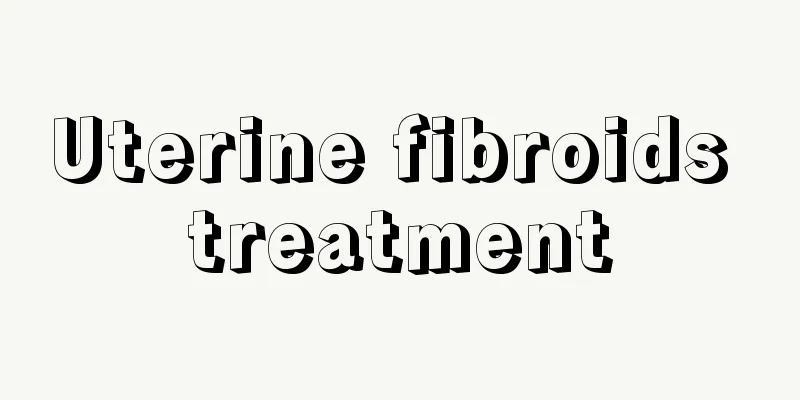Uterine fibroids treatment

|
If uterine fibroids do not have any particularly obvious clinical manifestations, no treatment measures are required, and there will be no malignant changes. However, you must go to the hospital regularly for relevant examinations. When your symptoms become very obvious, you must take some medication for treatment. The most typical drug is mifepristone, which can be used to treat diseases such as uterine fibroids. 1. Follow-up observation If the patient has no obvious symptoms and no signs of malignancy, regular follow-up observation can be performed. 2. Medication (1) Gonadotropin-releasing hormone agonist (GnRH-a) Currently, the commonly used GnRH-a in clinical practice include leuprorelin, goserelin, triptorelin, etc. GnRH-a should not be used continuously for a long time. It is only used for pretreatment before surgery, generally for 3 to 6 months, to avoid causing severe menopausal symptoms caused by low estrogen. A small dose of estrogen can also be supplemented at the same time to counteract this side effect. (2) Mifepristone is a progesterone antagonist that has been clinically tried in recent years to treat uterine fibroids. It can reduce the size of fibroids, but the fibroids often grow again after discontinuation of the drug. (3) Danazol is used for preoperative medication or treatment of uterine fibroids that are not suitable for surgery. Uterine fibroids may grow larger after medication is stopped. Danazol can cause liver damage and androgenic side effects (weight gain, acne, dull voice, etc.). (4) Tamoxifen can inhibit the growth of fibroids. However, long-term use may cause enlargement of uterine fibroids in some patients, and may even induce endometriosis and endometrial cancer, so this should be paid attention to. (5) Commonly used androgen drugs include methyltestosterone (methyltestosterone) and testosterone propionate (testosterone propionate), which can inhibit the growth of fibroids. The dosage should be used carefully to avoid virilization. During the bleeding period of patients with uterine fibroids, if the amount of bleeding is heavy, uterine contractants (such as oxytocin, ergot) and hemostatic drugs (such as hemostatic acid, aminobenzoic acid (hemostatic aromatic acid), lizhihemostasis, Panax notoginseng tablets, etc.) can also be used, which can play a certain degree of auxiliary hemostatic effect. 3. Surgery Surgical treatment of uterine fibroids includes myomectomy and hysterectomy, which can be performed abdominally or vaginally, or endoscopically (hysteroscopy or laparoscopy). The choice of surgical procedure and approach depends on factors such as the patient's age, whether or not they have fertility requirements, the size and location of the fibroids, and medical technology conditions. (1) Myomectomy is a surgery to remove uterine fibroids while preserving the uterus. It is mainly used for young women under 40 years old who wish to retain their fertility. It is suitable for patients with larger fibroids, heavy menstruation, compression symptoms, infertility due to fibroids, submucosal fibroids, and fast-growing fibroids without malignant transformation. |
<<: I got pregnant 2 days after my period.
>>: How long after recanalization surgery can I have sex?
Recommend
What to do if cervical erosion is moderate
The problem of cervical erosion has become so ser...
How long will it take to know you are pregnant?
Some women do not have any obvious reactions duri...
National Liver Health Day | Sometimes you feel depressed, sometimes you feel irritable, these symptoms of liver damage may be a disease!
March 18 is National Liver Care Day. The liver is...
Adenomyosis with fibroids
There are many posts about this disease on the we...
What is the cause of abdominal pain after cesarean section?
Lower abdominal distension and pain after cesarea...
The fastest way to treat heartburn in pregnant women
During pregnancy, many pregnant women experience ...
Is it painful to have a fallopian tube hydrotubation test?
Blocked fallopian tubes are the most serious fact...
What is the cause of low ferritin in pregnant women?
As we all know, pregnant women have weaker immuni...
How long does it take for the pelvic floor muscles to recover after childbirth?
Regardless of whether it is a natural birth or a ...
Vulvar leukoplakia symptoms and treatment methods
Vulvar leukoplakia has always been a disease that...
Lower abdominal pain after period
Women all know that during menstruation, their bo...
Sometimes thick, sometimes thin, the "face-changing game" of the endometrium, how much do you know?
Author: Chen Yongning, attending physician of the...
What are the benefits of cupping on a woman’s forehead?
Cupping is a very popular health care method. Man...
What causes breast pain in women?
Some girls begin to develop breasts at around the...
What is the meaning of ddys? What is the abbreviation of ddys?
There are often some people who use online social...









